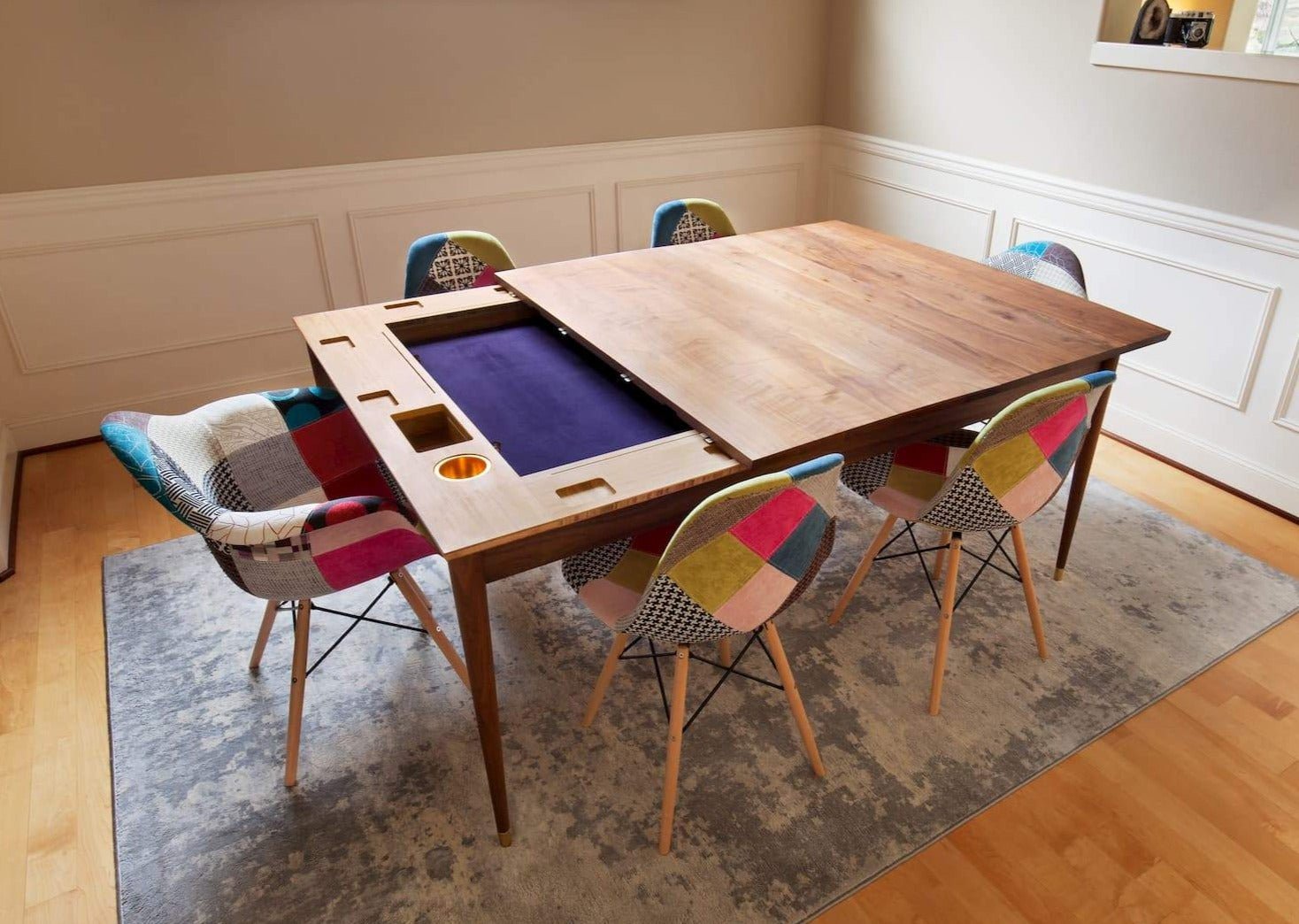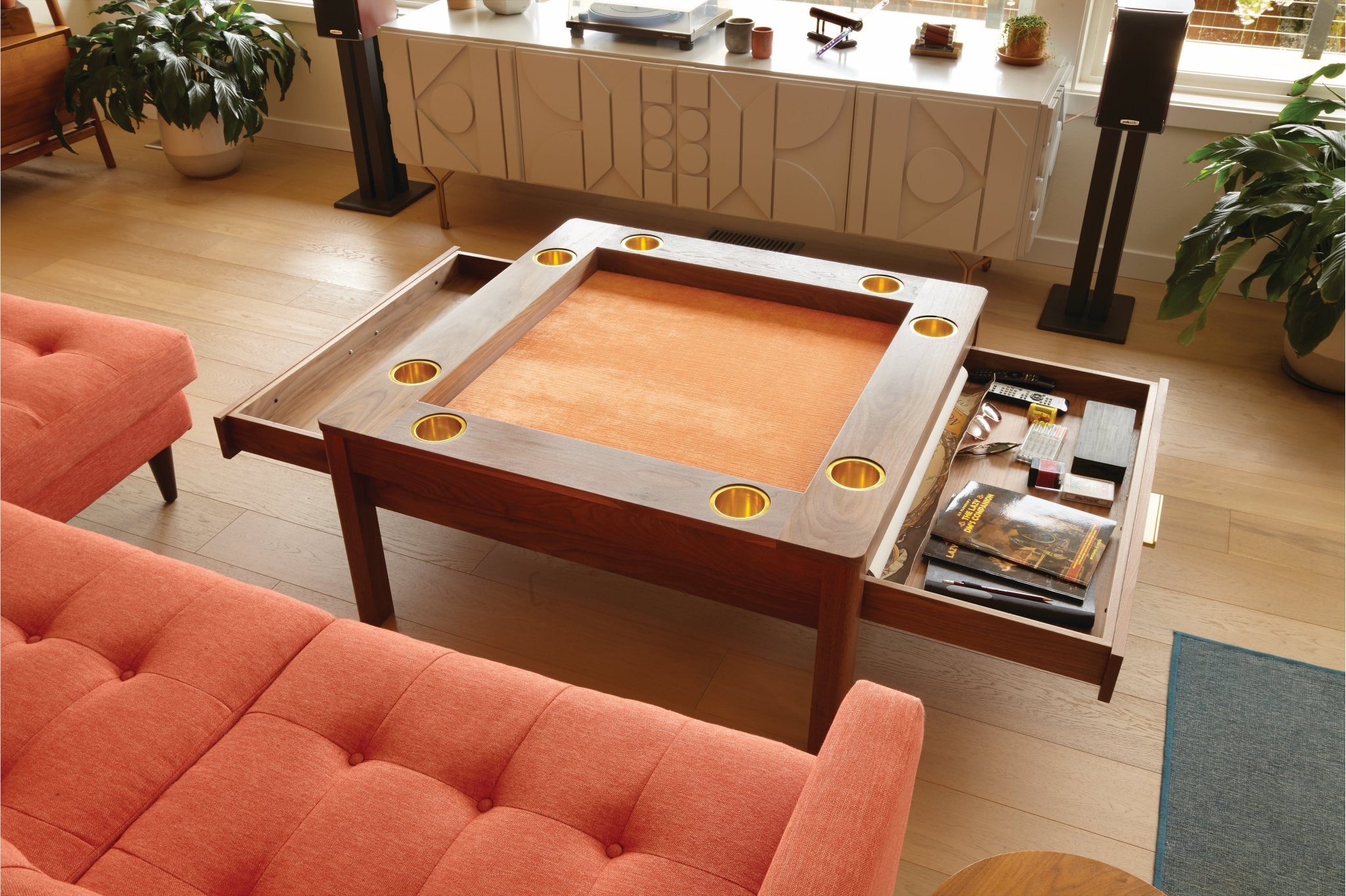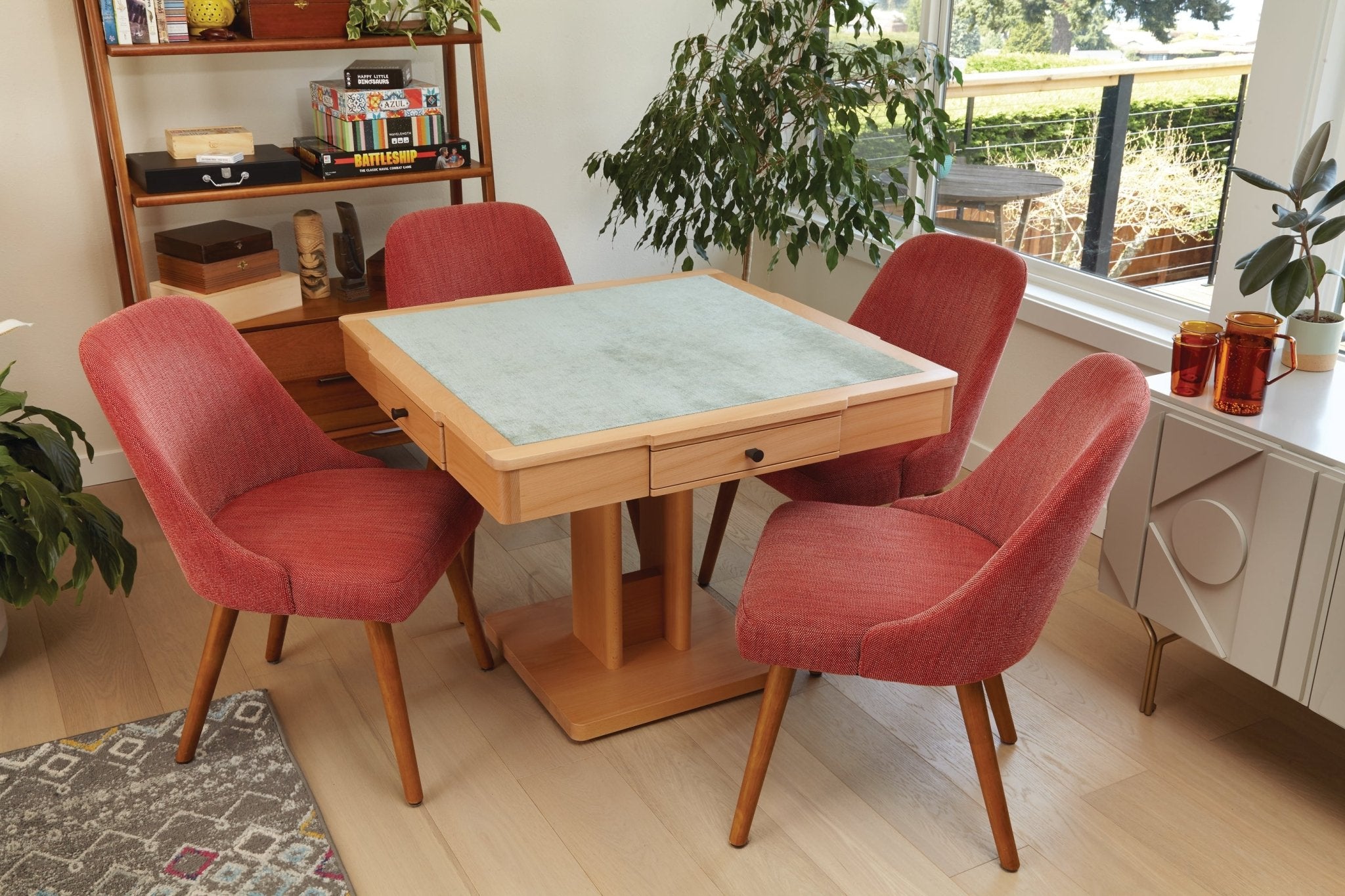Dining Table Alternatives
Traditional dining tables might look great, but they're big, bulky, and don't always fit well in modern living spaces where every square foot matters.
If your home lacks a dining area, it's time to get creative. You need a practical solution, like the Dresden, that lets you share a meal in comfort without sacrificing your home's aesthetic.
12 Dining Table Alternatives
There are many different types of dining tables available, but you don't have to pick one that's designed just for eating purposes.
Here are ten alternatives that give you all the functionality of a regular dining table, some with added benefits you won't get from traditional options.

1. Multipurpose table
A multipurpose dining table is the perfect solution for small spaces where you don't want to compromise on dining in style.
These functional dining tables serve dual purposes. For example, some models come with lots of built-in storage compartments so you can reduce clutter elsewhere.
Our favorite is the gaming table that effortlessly transforms into an elegant dining area.
The Dresden is our idea of the perfect dining table. Built for game enthusiasts, it features cup holders, card slots, dice bins, and a large, recessed gaming area.
Once it's done being a game table, lay the solid wood dining leaves on top, and that's it! You have a modern, stylish table that works equally well for casual meals and formal dinner parties.
This is the ultimate option for those who want space to socialize and enjoy a meal with friends, but don't have the room in their house for both.
2. Kitchen island
The kitchen island can serve as a functional dining table. Plus, those who eat get a front row seat to watch the chef at work!
The kitchen island works best for casual dining, quick breakfasts, and smaller families. It's probably not the best solution if you like throwing upscale dinner parties.
Choose a kitchen island with an overhanging counter so people can sit along it comfortably.
For a high-end seating option, go for height-adjustable bar stools with backrests. If space is at a real premium, stackable stools can be tucked out of the way when not in use.

3. Adjustable coffee table
An adjustable coffee table gives you the best of both worlds. A low, cozy surface for when you're lounging on the sofa, and a compact dining table that accommodates chairs easily.
Its secret is a height-adjustable mechanism that lets you move the surface to the desired level according to your needs.
The adjustable coffee table is a great option for small apartments that don't have the luxury of fitting in a full-size dining table. To save even more space, use folding chairs, since they can be easily stored and moved out of the room.

4. Expandable table
Expandable tables work really well when you don't need a large dining room for everyday use, but would like a way to accommodate more people when hosting.
These tables typically feature hidden or drop-leaf panels that increase the surface area when needed. Then, when your dinner party is over, you simply tuck the panels away again, transforming back to its original size.
Expandable tables are available in a wide range of materials and shapes, including round, oval, and square, so there is bound to be an option that matches your home decor.
5. Wall-mounted, folding table
For really tight living areas, having a tabletop mounted to the wall will give you a dining area without taking up any room at all.
These tables mount to wall studs and fold completely flat when not in use. When you're ready to eat, the tabletop folds down, giving you plenty of space to dine in style.
Beyond eating food, the folding table can also double up as a desk or worktop, making it a practical solution for studio apartments.
6. Side tables
If you don't want the hassle of fitting multiple chairs or stools in your space, the side table offers a way to dine from your couch - while binging your favorite TV series.
These tiny tables are typically used to place drinks, lights, or ornaments, but they serve just as well as a dining area for one.
The huge variety of available styles, sizes, and heights means you'll easily find options that complement your existing furniture. Look for models with surfaces large enough for a big plate plus a drink.
7. Workstations and benches
Workstations and benches adapt beautifully into dining surfaces with just a few simple adjustments.
Go for a lower option if you want to accommodate chairs, or a higher option if you prefer to use bar stools.
And if you install wheels on the bottom, they can be easily moved around the living area without risking your back or damaging the floor space.
Like many table alternatives on this list, a workstation or bench can be used for many things other than eating food, making them convenient for small spaces.
8. Custom tables to fit tight spaces
Many homes, especially period houses, come with nooks and crannies that don't fit conventional furniture. Rather than letting the space go to waste, see if it can be adapted into a dining room.
For example:
-
Bay windows are a great place to install a dining nook.
-
The space beneath the staircase can easily become a small dining zone, complete with a built-in bench or narrow table.
-
Custom-shaped tabletops can be fitted into oddly-shaped corners.
If you have the know-how, you could create the area yourself. Or, if budget allows, have a skilled craftsman build you something truly unique.
9. Rustic DIY dining set
If you're handy with a hammer, a dining table can be made from just about anything. Plus, a DIY table can be an excellent conversation starter.
-
Old wooden doors make excellent tabletops after proper sanding and finishing.
-
Have some wooden crates lying around? Fix them together to make a table with built-in storage.
-
Repurpose cabinets or sideboards by adding wooden panels to increase surface area.
-
Large wine barrels work particularly well for outdoor dining or creating cozy, intimate spaces indoors.
Take a look at what you've already got around the house that you can use, or check out salvage yards, reclaimed wood yards, and local businesses to see what they have available.
Then, let the creative juices flow!
10. Do it Japanese style
Traditional Japanese dining involves a low eating area, similar to a coffee table, with people seated on cushions. So, if you don't want a height-adjustable coffee table, this could work really well.
You could go one step further and invest in a multi-purpose coffee table, like The Firefly.
This transforms from a stunning gaming table to a low dining spot. And it comes with extra storage to stow away gaming equipment or dining sets.
All you need are some big comfy cushions, and you have a cozy yet highly functional space.
Chopsticks are optional!
11. Camping or trestle table
The humble camping table was made to be practical and transportable. It folds flat, so it can be stored without getting in the way, and it's lightweight, so you don't have to lug it around.
The trestle table is the camping table's larger and sturdier cousin, and is typically used for functions or events.
While probably not ideal for everyday use, these options can be brought out when you have to accommodate a large number of guests or if you're throwing a party.
They give you plenty of surface to lay down a buffet or set up a self-serve meal so guests can help themselves without crowding the kitchen.
12. Sideboards and consoles
They may not scream “dining room,” but with the right setup, sideboards and consoles can absolutely work.
Pull them away from the wall, pair them with a couple of stools or benches, and suddenly you’ve got a slim dining surface. Perfect for casual dining and small spaces.
If you're worried about legroom, add a piece of wood on top to extend the depth and create an overhang, and secure it with clamps or non-slip pads.
How to Find the Right Solution for Your Dining Area
When considering what to create or repurpose as a dining table, think about the following:
-
Choose the right size object or surface. You will need around 36 inches around the table so people can move comfortably, even when chairs are pulled out.
-
Match the table height to your seating. Standard dining tables are around 28–30 inches high. Bar-height or counter-height setups call for taller stools.
-
Prioritize stability. You don't want the table to wobble or risk tipping over when people tuck into their meal.
-
Consider versatility and function. If space is tight, go for something that folds, extends, or doubles as a desk or prep surface. Or, pick a multifunctional option.
-
Think about effort. Tables that fold away or are stored when not in use shouldn't be too cumbersome to move around. Tables that double up for other uses should be adaptable without being a hassle.
-
Budget also plays a role. Think about how much you have to spend and find solutions that don't leave you out of pocket.
How to Get the Formal Dining Room Vibe With an Unconventional Table
Want an upscale dining room experience, but are worried your dining space doesn't cut the mustard? Try out these ideas:
-
Use a high-quality tablecloth or runner. It instantly disguises irregular surfaces and gives visual appeal.
-
Use proper dining chairs. Even if the table’s unconventional, matching seating creates structure and formality.
-
Adding a pendant light or chandelier above the table makes the space more inviting.
-
Go all in on tableware. Real plates, cloth napkins, nice glassware, matching cutlery, etc.
-
Wow guests with thoughtful centerpieces and decor. Match them to the theme of the occasion.
-
A mirror, artwork, or large framed print behind the table gives the space a polished look.
-
Dimmable lighting, background music, and candles can turn even a kitchen island into an upscale scene.
FAQs
What can I have instead of a dining table?
Any sturdy flat surface can work as a dining table. A coffee table, a kitchen island, side tables, and even workspaces make good alternatives.
What can you put in a dining room besides a table?
Besides a table, suitable dining room furniture options include:
-
A buffet or console to store dishes and cutlery
-
A drinks cabinet
-
Statement lighting
-
A large mirror or artwork
-
A display shelving unit or cabinet
-
Comfortable seating
-
Soft touches, like a rug, curtains, and cushions
How to entertain without a dining table?
To entertain without a dining room or table, you could host buffet-style using a sideboard, counter, or console as your serving area.
Set up a few smaller surfaces, like nesting tables or trays, for guests to place drinks and plates. Focus on creating a relaxed, social atmosphere rather than a formal sit-down meal.
Is it okay not to have a dining table?
Yes! It's fine if you don't have a dining table. Plenty of people live happily without one, especially when they live in a small space.
What matters is creating a dining spot that fits your lifestyle, whether that’s a kitchen counter for quick breakfasts or a fold-out setup for sit-down dinners. As long as you’ve got a comfortable place to eat and gather, a dining table isn't important.
What can you use as a table top?
Anything flat and sturdy works well as a tabletop. Try reclaimed wood planks, old doors, butcher block, marble slabs, plywood sheets, or even tempered glass. You can also upcycle pallets, flooring panels, or countertops. Just make sure it’s stable, smooth, and sealed if you plan to eat off it.
Final Thoughts
Whether you need a solution for a small space or want to entertain many friends, there are plenty of interesting alternatives to the bog-standard dining table.
For the ultimate combination of dining and entertainment, consider a family gaming table that transitions between elegant dinners and fun game nights. Clear the dishes, deal the cards, and keep the good times rolling in the same space.



